Identify Which Roles Are Critical To Company Strategy
Identify which roles are critical to your company’s business strategy by asking these 3 simple questions. Then focus on those roles.
The 9 steps to building a completely custom competency model, and the organizational buy-in necessary to make it successful, over just a few weeks!
Competency models (also used as capability models) can be used as the foundation of your talent management strategy because they drive value across the entire employee lifecycle. However, the upfront investment can look daunting.
In this guide, we will take you through the 9 critical steps to building both competency models and the organizational buy-in that you will need to make them successful. We will show you how to streamline this process so that you can run this play in just a few weeks.
| Description | Time Needed |
| Step 1: Select a role | Variable |
| Step 2: Identify high performers | 1 week (for survey) |
| Step 3: Schedule competency mapping workshop | 1 hour |
| Step 4: Facility competency mapping workshop | 8 hours (1 full day) |
| Step 5: Editing round | 4-8 hours |
| Step 6: Stakeholder review | 2 hour |
| Step 7: Validate with workshop participants | 1 hour |
| Step 8: Validate with Senior Leaders | 1 hour |
| Step 9: Publish competency model | 1 hour |
These models can take many forms, including leadership models, technical capability or competency models, values behaviors, etc. Whatever your intent, base it off of what the business is trying to achieve and customize it to your organization. We have found that tying a competency model to a specific role is the best approach.
Determine which roles could most benefit the organization if they had a competency model. Note that when we refer to a “role” here, these can be vertical roles (ex: technical job / field like an electrician) or a horizontal role (ex: a certain layer of management).
Refer to our Aligning Skills & Goals article to learn how to prioritize which role to focus on and prioritize with your team. We encourage you to look at organizational data (ex: turnover rates, succession timelines, etc.) as part of your research.
Once you have selected a role, it is time to select your Competency Mapping Workshop participants. The participants should be the highest performing individuals in that particular role.
This step is especially critical when you’re just beginning to build support for a competency-based approach. Survey your organization to gain consensus on these high performers. This is a great opportunity to collaborate with key stakeholders and build buy-in to the process.
Collect nominations from these key stakeholders to determine the 4-6 high performers to participate in the Competency Mapping Workshop. Here are the things you will want to include in your communications:
Context
Nomination Questions
Reach out to the nominations and congratulate them for being nominated. Explain how important this work is and how much impact it will have on the organization.
Work with the group to find a day where they can physically be in the same space for an entire day (8 hours) with minimum distractions. It is important not to have people rotating in and out or being called away with phone calls. The workshop is a long, intense day and will require their undivided attention to be done correctly.
It is possible to do these workshops virtually, however, it is very challenging and you have to work extra hard to finish with the same quality model. We've learned how to mange this through high energy facilitation, breaking the workshop into "chunks" and having fewer participants.
This is the main event. Reserve a room and plan for an entire 8-hour day with your high performers. The purpose of the workshop is to break the role into categories, then skills and finally a multi-level rubric of behavioral anchors.
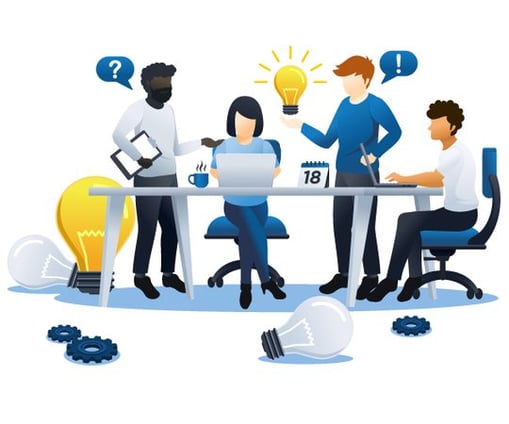
Workshop Checklist:
Before the Workshop
Materials Needed
Flow of the Day
Take the time to setup the day and explain the importance of this work. You need your workshop participants as engaged as possible. Here is a general agenda of the day’s flow and about how long each part should take.
| Time | Topic |
| 60 min | Introductions & Context |
| 10 min | Values & Strategic Goals Review |
| 60 min | Category & Skills Brainstorm and Consolidation |
| 60 min | Behavioral Anchors drill down of first skill (start with the hardest) |
| 20-45 min | Behavioral Anchors drill down per additional skill (where most of the time is spent |
| Breaks | Provide regular breaks as needed |
| 10 min | Brainstorm characteristics of success |
| 10 min | Brainstorm aligned interview questions |
| 20-30 min | Discuss existing learning solutions |
Introductions & Context
Be very thoughtful about how you introduce competency-based development to an organization that has never used it before. Make sure that you explain it in terms that they understand and see the value in it for them. We’re happy to share our slides with you if you need some help!
Category & Skills Brainstorm & Consolidation
There are many frameworks out there for building competency models, but we typically find the pyramid below helpful to explain the primary types of skills in an organization. The role that you’ve chosen to focus on will typically dictate which types of skills need to be included.
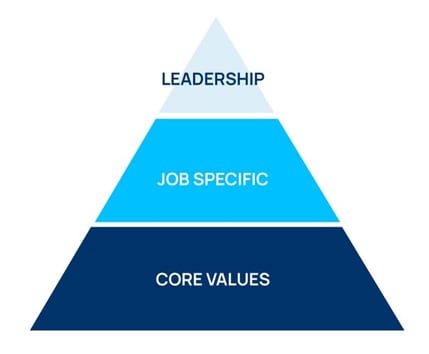
For those building a truly custom competency model, ask each participant to write down on their own paper as many categories / skills / topics that they can think of that are important to doing their role. Give them 5 minutes for this and then go around the room, having each person share just one item on their list until all have been captured on the screen / board.
Keep the group at a fairly high level during this brainstorm, but capture all of the topics they share and use them as check during the next step of the process (Behavioral Anchors).
Next, organize your brainstorming into natural clusters of categories and skills.
In the example below, we were building a set of leadership competencies for a client, so we identified 3 major categories and then 3 skills within each category. We ultimately created 5-level rubrics of behavioral anchors (next section) for each of the skills..png?width=295&name=Skills%20Example%20(leadership).png)
Once you’ve organized the model into clusters of skills, tackle the hardest / most complicated one first and build out the behavioral anchors. You want to tackle the hardest one first because you want them to get easier as the group’s energy wanes.
Behavioral Anchors
This is where the work and the value is. A good facilitator will help your highest performers get what makes them so good out of their heads and down on paper for the benefit of the rest of the organization.
We recommend a 5-level rubric that takes someone from “Learning” to “Expert” in a particular skill. This progression is incredibly important and is the key to creating the “map” to exceptional performance for your workforce.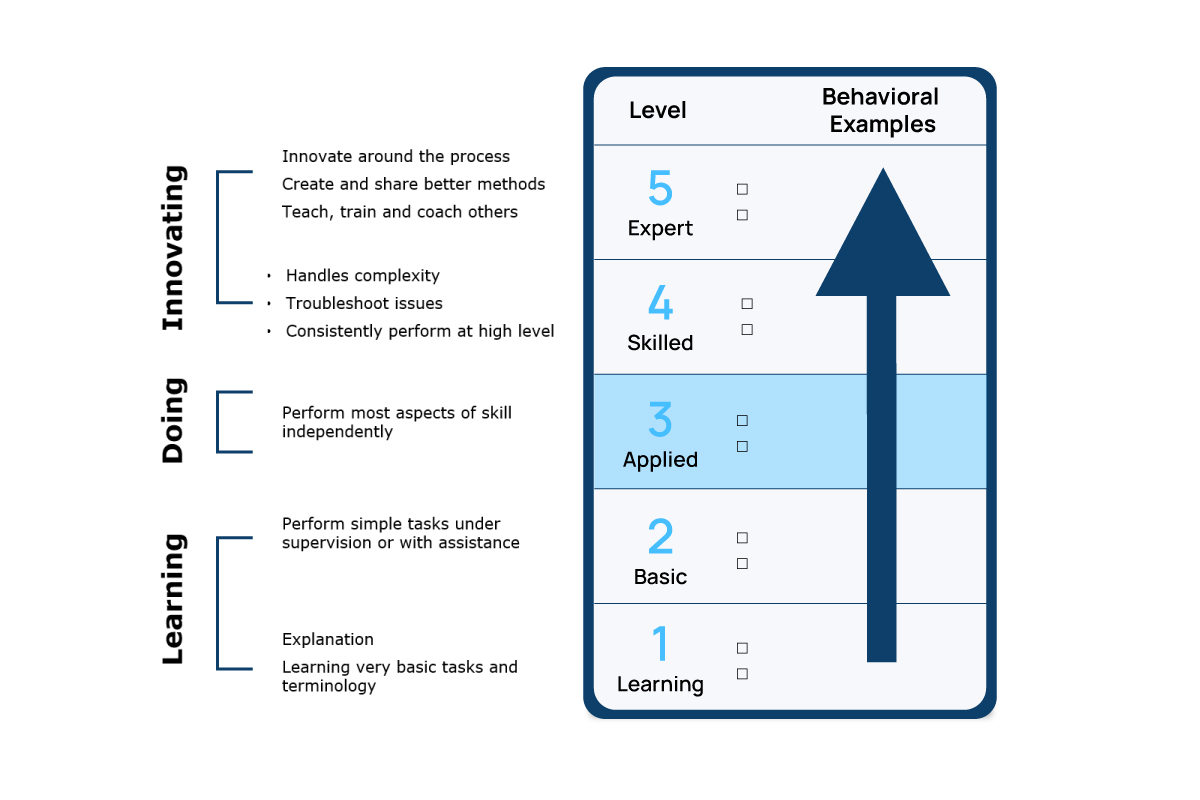
There are 3 keys to writing quality behavioral anchors. They should be written:
Let us know if you’d like to see some examples!
Brainstorming Characteristics of Success & Interview Questions
Your group will be pretty worn out by the time you have completed building out the behavioral anchors for each skill, but we always take the last few minutes to brainstorm the characteristics (intangibles) of success and potential interview questions for someone in this role.
The group has spent the entire day in the head space of this role and are typically able to provide a wealth of interesting insights.
Learning Solutions
Finally, and only if it is applicable to the situation, we identify any pertinent learning activities that they felt were particularly impactful on their success in a particular skill / behavior.
This is not featured in the competency model per se, but recorded for later when the competency model is used to drive development planning.
Your final activity of the day is to take a picture of the group. You’ll see why soon.
The goal of the workshop is to capture everything you can about the actual behaviors of the top performers in your organization. You leave the workshop with a rough draft and will need to spend time editing the document (step 5).
After you’re happy with it, take the competency model through a series of validations with key stakeholders, back to the workshop participants and finally through senior leadership.
You certainly want key stakeholders / leaderships’ editing suggestions – do they think behaviors are clearly worded, at the right level, etc. – but the most important part of this validation process is gaining buy-in.
People who have had a hand in building the competency model will not very quickly resist it. No one thinks their baby is ugly. It takes time, but it is worth it. Once you’ve made the rounds and the editing is finished, there is one last step.
Your final step is to put the group picture taken at the end of the workshop on the front of your competency model.
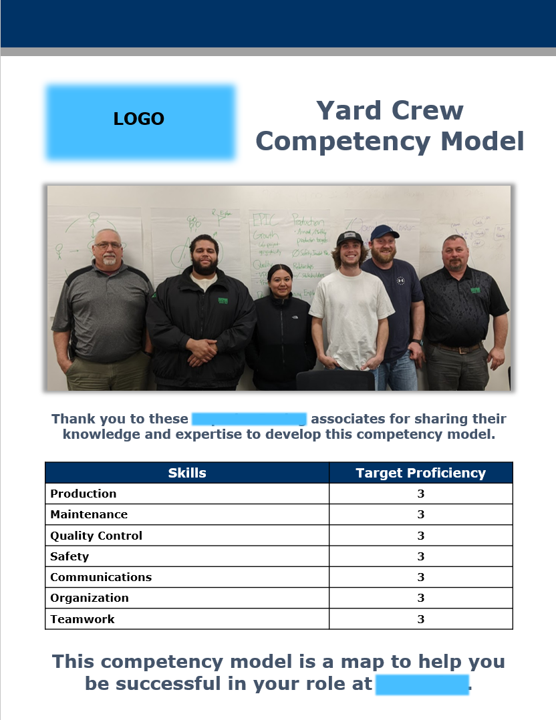
The picture is key because it says that this model was created and is owned by the people in that role. The best of their group developed the model – not the executives, not talent development and certainly not outside consultants – but them.
Now you’re ready to publish the competency model and begin to realize the immense value of your work.
At the beginning of this article we challenged you to envision a world where every employee at your organization knew which skills would make them most successful within their role. We then shared how to create aliment and buy-in from key stakeholders as part of the process and finally, how to actually build your own custom competency model.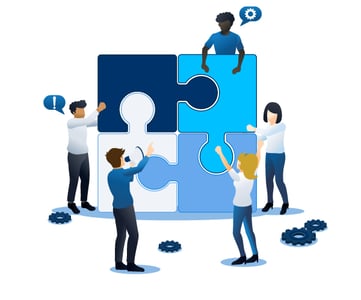
You can now build a clear definition of success (competency model) that you can use to measure, plan and develop your workforce against. Business leaders will begin to appreciate the power in integrating development and performance and will make you a true partner in achieving business outcomes.
Now that you have the framework and road map to define these critical skills for your organization, we encourage you to checkout our other resources to see how best to use your competency models to best drive performance and development.
Happy developing and know that we’re here if you get stuck and need help!
If you're interested in exploring how ATLAS Navigator's software is optimized specifically for powering competency models, set up a free Insights Call with us!
Identify which roles are critical to your company’s business strategy by asking these 3 simple questions. Then focus on those roles.
Avoid the typical cultural minefield faced when implementing a competency-based talent strategy in your organization.
Implement a competency-based talent strategy in your organization by using this journey analogy to build buy-in.
Still in research mode? Subscribe to our periodic insights and resources to see if we're a good fit for you.